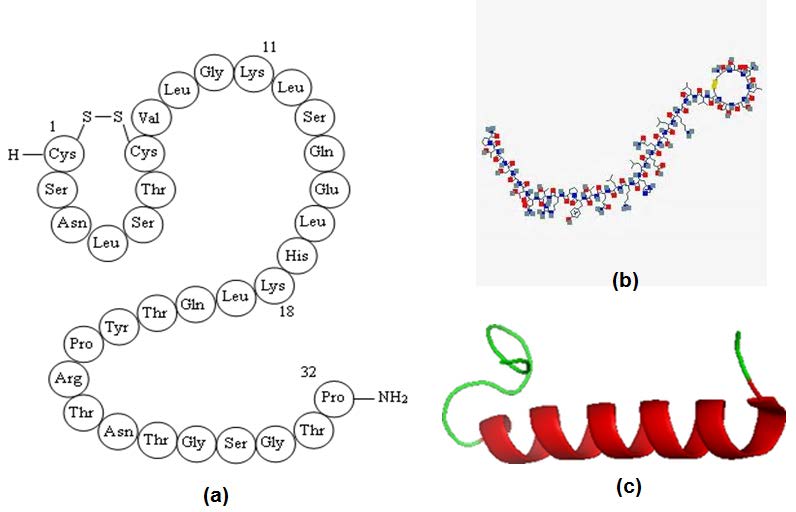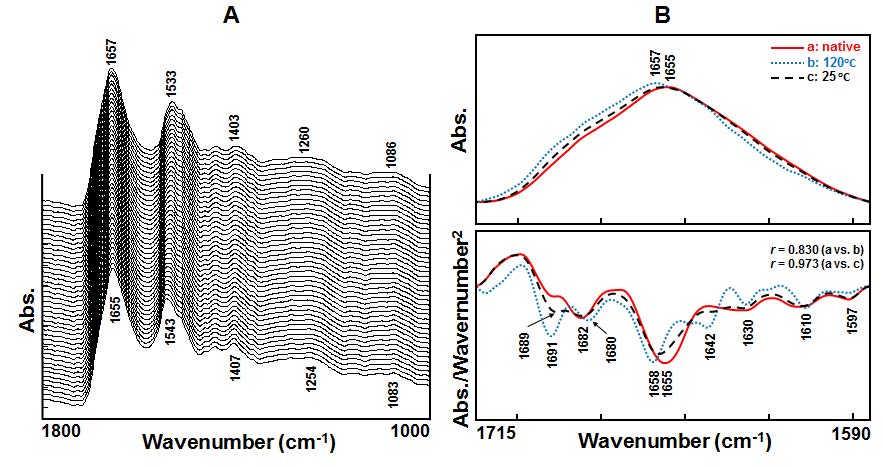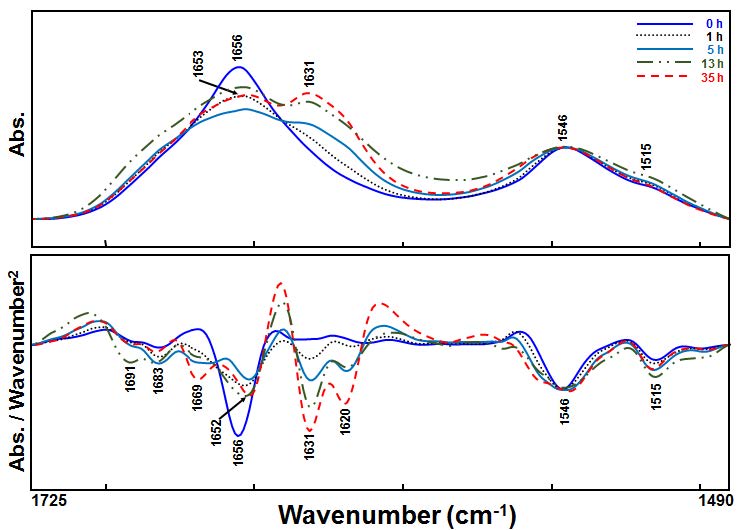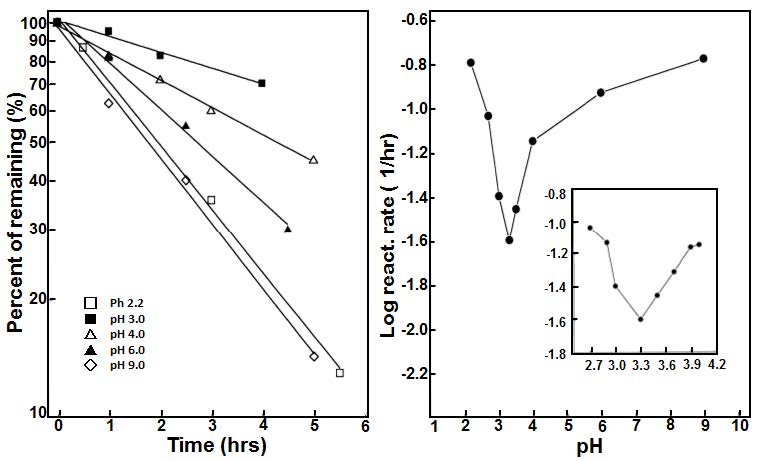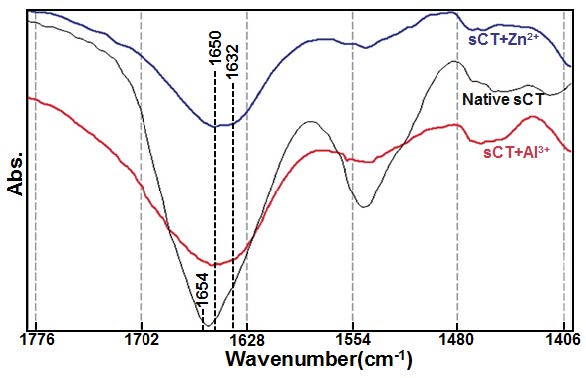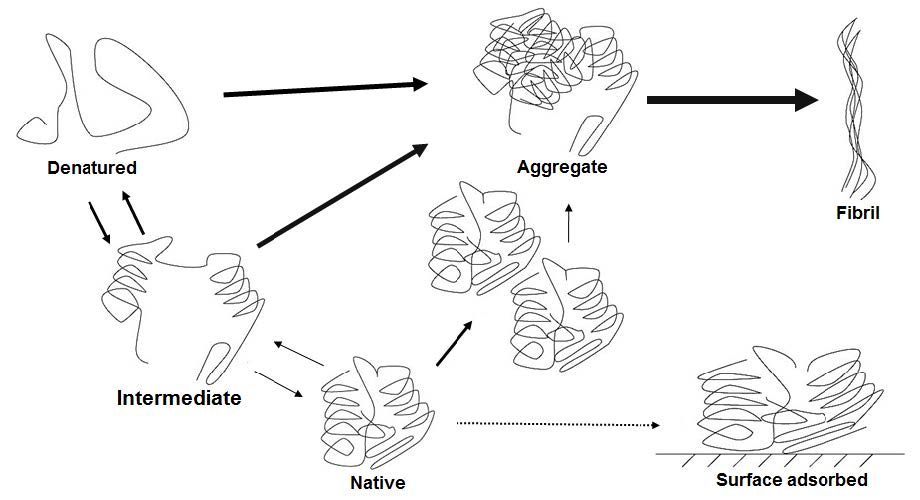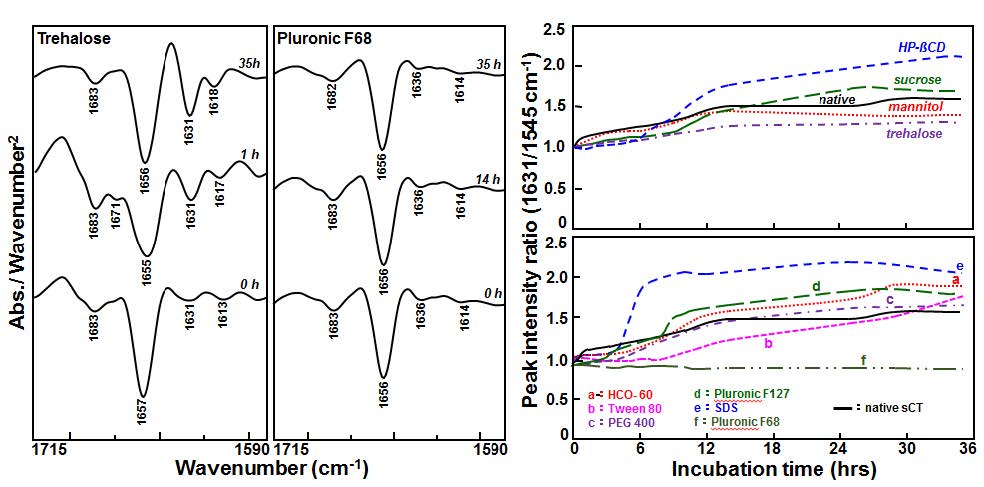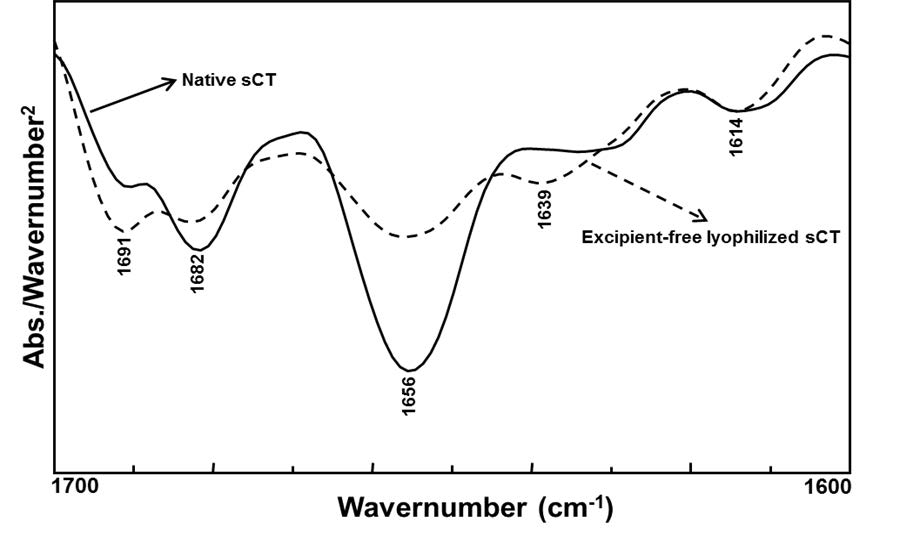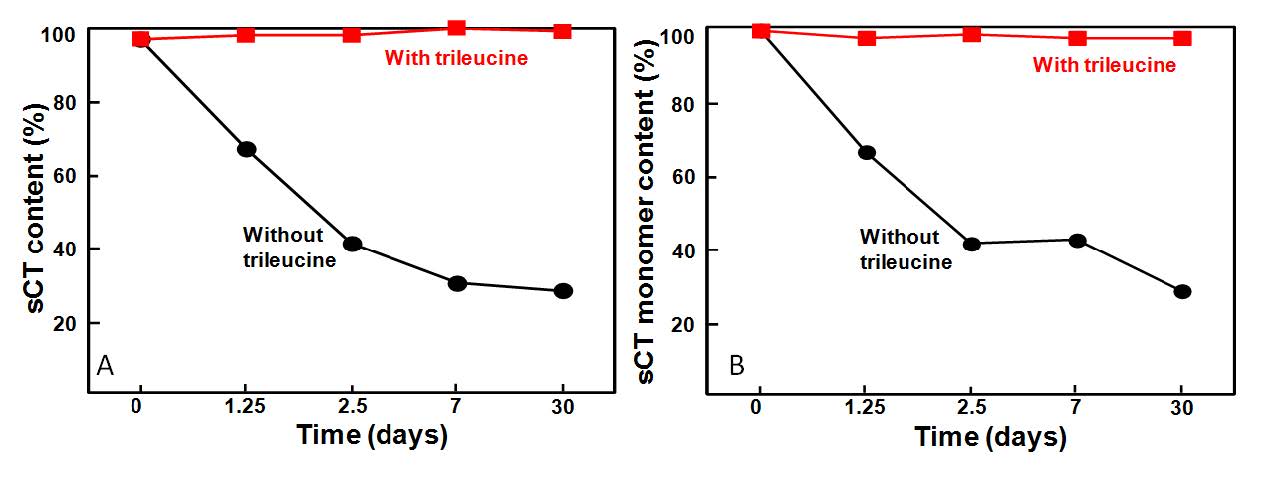1. Introduction
In recent years, peptides or protein drugs as potential biopharmaceutical medicines have gained considerable attention in the treatment of severe diseases, such as cancer, diabetes, hemophilia, and osteoporosis, because of their high potency, specificity, and selectivity [1,2,3,4,5]. Because of the success of many peptides or protein drugs in the biotechnological and pharmaceutical markets, numerous pharmaceutical and biotech companies have become increasingly interested in peptides or proteins as new drug discovery targets [7,8]. Currently, many therapeutic peptides or protein drugs are being developed and tested in clinical trials. However, the major concern in developing these therapeutic peptides or protein drugs is stability [5,9,10,11].
2. Physical and Chemical Stability of Peptides and Protein Drugs
Generally, most peptides or globular proteins are marginally stable under physiological conditions because the free energy released when the protein folds into its native conformation is relatively small (approximately -5~-10 kcal/mol−1) [12,13]. However, protein molecules are both structurally complex and chemically reactive, which results in their susceptibility to physical and chemical instability [14,15,16,17,18,19]. When subjected to various environmental stresses, such as temperature, storage time, agitation, freeze-thaw cycles, and lyophilization, peptides or protein drugs can become chemically and/or physically unstable [16]. Chemical instability refers to the formation or destruction of covalent bonds within a peptide or protein molecule. These changes alter the protein’s primary structure and affect its higher-level structure. The common causes of chemical instability are hydrolysis, deamidation, isomerization, racemization, oxidation, disulfide exchange, dimerization, β-elimination, and Maillard reaction [9,10,11,14,15,16,17,20], and those of physical instabilities include denaturation, aggregation, precipitation, or adsorption to surfaces [14,20,21,22,23,24]. Figure 1 shows the possible mechanisms underlying physical and chemical degradation of peptide and/or protein drugs. In addition, physical and chemical instability reactions can occur simultaneously or one may lead to the other.
Peptides or protein drugs with folded conformations are more stable than those with unfolded ones. Most of these drugs must fold into a globular conformation to perform their biological function in living organisms [20]. However, the native functional structure of folded peptides or proteins is easily disrupted by various environmental conditions, such as pH, temperature, pressure, buffers, metal ions, excipients, and denaturing agents [5,14]. The disruption process may alter three-dimensional structure of a protein, resulting in a drastically change to the secondary structure of protein. The secondary structure is the formation of regular local structures such as α-helices and β-sheets within a single protein sequence through the formation of hydrogen bonds [25,26,27]. Since the folding of secondary structure generally correlates with overall protein hydrophobic stabilization and local folding preferences [28], thus the stability of protein drugs should be evaluated during development, in the course of the manufacturing process, and in long-term storage [5,14,15,29]. In general, there are two types of formulations for protein drugs: liquid and solid. To ensure protein stability in both formulation types, the factors that cause chemical and physical instability of these peptides or proteins must be understood. Because the therapeutic activities of peptide or protein drugs are highly dependent on the conformational structure, how to retain the native conformations of peptide or protein drugs in the production processes is a key issue [4,5,14,21,22].
3. Thyroid Polypeptide Hormone Calcitonins
Among the different types of peptides or protein drugs, calcitonin (CT) is well known as participating in many diverse physiological functions in humans [30,31,32]. Thus, CT has been considered to be a suitable peptide drug candidate for investigations. CT is an endogenous thyroid polypeptide hormone composed of 32 amino acids, has a molecular weight of 3454.93 Da and is secreted by the parafollicular cells of the thyroid gland in mammals or by the ultimobranchial gland in nonmammalian species [33,34]. CT has been discovered in fish, reptiles, birds, and mammals, including humans [35]. The major physiological role of CT in humans is to control the concentration and metabolism of calcium in the body in which calcium has an important role in most cell activities, including muscle contraction, mineralmetabolism, calcium homeostasis, blood coagulation, and extracellular transition of nervous signals [36,37]. Therefore, CT has been widely used for treatment of osteoporosis, hypercalcemia, Paget’s disease, bone metastatic pain, and chronic pain in terminal cancer patients and may also be an acceptable alternative for patients who cannot take bisphosphonate drugs [38,39,40]. The amino acid sequences of different types of CT have been determined for many species, and the basic structure of CTs is characterized by an intramolecular disulfide bridge between the cysteine residues at positions 1 and 7 (Figure 2) and an amidated carboxy-terminal in which the specific amino acid residues are identical for all CTs [41,42,43].
4. The Role and Stability of Salmon Calcitonin
Of the different types of CT available for clinical use, salmon calcitonin (sCT) is one of the most potent [38,44,45]. Previousstudies have found that sCT differs from human CT (hCT) at 16 amino acid residues and is several times more potent than hCT [46,47]. In addition, sCT is one of the bioactive peptides that require C-terminal amidation for full biological activity [39,48]. It has been reported that sCT is 50% identical to hCT and has a longer half-life and better receptor affinity, which make it more potent and longer lasting than hCT [39,49]. Currently, sCT is produced either by recombinant DNA technology or by chemical peptide synthesis [50]. Figure 2 shows the primary and secondary structures of sCT [43]. The drug is commonly administered via intramuscular, subcutaneous, or intravenous injection. Although numerous investigations have been conducted on delivery of sCT through various routes, such as nasal, rectal, oral, and vaginal systems, and through implants [41,51,52,53]; only nasal delivery has successfully reached the pharmaceutical market. Currently, sCT has been commercialized as injection and nasal spray formulations [38,54,55].
Like that of many peptides and proteins, therapeutic use of CT is hindered by its physical instability [56,57,58,59,60,61]. Among physical instabilities, protein aggregation is one of the most frequent concerns and can occur during all stages of the lifetime of a protein therapeutic [9,59,60,61,62]. Aggregation is a complex process and is dependent on various factors, such as pH, ionic strength, buffer systems, temperature, protein concentration, excipients, or stresses applied, such as freezing, thawing, or shaking [63,64,65,66,67,68,69]. It has been reported that a 1-7 disulfide bridge in the sCT structure may cause instability of sCT [70,71,72]. Under thermal stress, sCT undergoes β-elimination to produce free thiols and finally results in degradation via various pathways [73]. Thus, maintenance of the stable forms of sCT products throughout the development process, storage, transportation, and patient administration is the principal issue facing the biopharmaceutical industry today [9,74,75,76,77]. Therefore, how to stabilize sCT in either aqueous solution or the solid state is an important aspect in development of CT therapies.
Chang et al. reported that a solution formulation of sCT was not suitable for long-term storage because the kinetics of thermally dependent degradation of sCT followed a first-order reaction [78]. They concluded that the degradation pathway could be different at the pH and higher temperatures used. In addition, in aqueous solutions, hCT had a pronounced tendency to form fibrillar aggregates and/or amyloid fibrils after different treatments [79,80,81,82], which was a major reason for incomplete release of peptides from delivery systems and decreased biological potency [83,84,85]. Stability problems of sCT may also occur in sustained release systems because of the high concentration of calcitonin in the polymer matrix [86]. Moreover, sCT has also been reported to be susceptible to chemical modifications, such as disulfide breakage and subsequent trisulfide bond formation, dimerization through covalent bonds, backbone hydrolysis, and acylation in poly(D, L lactide-co-glycolide) polymer-based microsphere delivery systems [87]. These chemical modifications have been shown to decrease the bioactivity of the peptides and even result in immunogenicity [88,89].
Because the therapeutic activity of protein drugs is highly dependent on the conformational structure, retaining the native conformation of a protein during the production processes is a key issue [9,84]. The secondary structures have important roles in protein structure and folding [90,91,92,93,94]. Herein, an overview of the conformational changes and stability of the sCT structure in solid and aqueous states is described. Moreover, the possible improvements obtained by using various stabilizers in preventing protein denaturation of sCT are introduced. The Fourier transform infrared (FTIR) spectroscopy is a well-known powerful tool with nondestructive and molecular “fingerprinting”capabilities for studying the structural characterization of proteins [95,96,97]. The conformational sensitivity of the amide bands includes hydrogen bonding and protein secondary structure, which is sensitive for Fourier transform infrared (FTIR) spectroscopic determinations. In this review article, FTIR spectral studies on the conformational changes and stability of sCT are mainly discussed.
4.1. Conformational stability of native sCT in the solid state
Retention of the native structure of a peptide or protein drug in the solid state is one of the critical criteria necessary to achieve a stable biopharmaceutical formulation [98,99]. To overcome instability of peptides or protein drugs, the drug often has to be made into a solid form to achieve an acceptable shelf life as a pharmaceutical product [100,101]. However, the long-term storage stability of these peptides or protein drugs may be very limited, especially at high storage temperatures. In some cases, protein stability in the solid state has been shown to be equal to or even worse than that in the liquid state, depending on the storage temperature, formulation composition, and drying technique [100,101,102,103,104,105]. Although peptides or protein drugs are not often used in their original state without any formulation design, understanding the intrinsic conformational stability of the native sCT in the solid state is very important before formulation and process development. Lee et al. used thermal FTIR microspectroscopy to investigate the intrinsic thermal stability and conformational structure of solid-state sCT before treatment [106]. A three-dimensional plot of the FTIR spectra of sCT from 1800 cm−1 to 1000 cm-1 as a function of temperature is shown in Figure 3A. It is evident that the amide I band of the native solid sCT had a maximum peak at 1655 cm−1, which was associated with the α-helix structure [106,107,108] and suggested that a higher proportion of the α-helix conformation existed in the native solid sCT before thermal treatment. During the heating process, the shape of the amide I band in the IR spectra did not significantly change with increasing temperature. Although slight shifts in several band positions with increasing temperature were observed, there was almost no marked alteration. This shifting phenomenon might have been due to the temperature-dependent dissociation of hydrogen bonding within the solid-state sCT structure.
The thermally dependent original and second-derivative spectral changes in the amide I bands of solid sCT before and after thermal treatments were also compared, as shown in Figure 3B. In addition to the predominate peak at 1658 cm−1 (α-helix), a strong peak at 1691 cm−1 and additional peaks at 1642, 1630, and 1610 cm−1 were observed in the second-derivative IR spectra when a solid sCT sample was heated to 120 °C. These additional three peaks might be attributed to the appearance of high-wavenumber β-sheet, random coil, and low-wavenumber β-sheet structures at higher temperatures, respectively [82,108,109,110]. After cooling to room temperature, however, these additional IR peaks disappeared, and the spectrum became similar to the original IR spectrum of the native sCT sample before heating. Lee et al. used a spectral correlation coefficient analytical technique between two second-derivative amide I spectra to verify their structural similarity [106]. The thermal FTIR microspectroscopic data clearly showed that sCT in the solid state was not affected by temperature and had a reversible thermal property during the heating-cooling process, as shown by the high correlation coefficient (r) value for the structural similarity of the solid-state sCT samples before and after thermal treatments.
Seyferth and Lee [82] indicated that a pure solid sCT had a dominating FTIR band at 1656 cm−1 attributable to the α-helix structure [107], which indicated that the solid-state sCT had a central met8-pro23region above the cys1-cys7N-terminal loop, as seen for hCT [109,110]. A second band at 1612 cm−1 was assigned to the intermolecular β-sheet. On the other hand, after treatment of sCT with EDTA, the FTIR spectrum of the isolated sCT/EDTA precipitate was dominated by two strong bands at 1668 cm−1and 1627 cm−1. The former corresponded to the β-turn structure, and the latter was attributed to the intermolecular β-sheet. A third band at 1656 cm−1was much reduced. Compared with the pure solid sCT (predominantly α-helix), the isolated sCT/EDTA precipitate had a predominantly β-sheet character. A structure with a decrease in the α-helical band with an increase in intermolecular β-sheet structure might be similar to the fibrillated hCT structure in water [82,109].
4.2. Conformational stability of native sCT in the liquid state
At present, there are two dosage forms of sCT for treatment of bone diseases. Recombinant and synthetic sCT nasal sprays (solution) and synthetic sCT injectable formulations (solution and lyophilized powder) are approved in the USA [38,111,112]. It is well known that the stability of a protein can be perturbed by changes in the solvent environment, which leads to changes in the biological activity of the protein because of protein-solvent interactions [113,114,115]. Particularly, the folding/unfolding equilibrium of proteins in aqueous solution can easily be altered by addition of small organic molecules, which are referred to as cosolvents [116,117].
Time-dependent changes in the FTIR spectra of native sCT in aqueous solution after incubation at 40 °C were studied by Lee and Lin [118,119,120], as shown in Figure 4. Two characteristic peaks at 1656 and 1546 cm−1 assigned to the major a-helix structure were observed, which implied that the native sCT in aqueous solution primarily contained a higher amount of the a-helical structure. This result was consistent with those of other structural reports [107,110,120]. By increasing the incubation time under 40 °C conditions, the peak at 1656 cm−1 gradually shifted to 1653 cm−1 because of the combination of a-helix and random coil. However, the IR peak intensity for a shoulder at 1631 cm−1 assigned to the low-wavenumber β-sheet also increased with incubation time [82,108,109,110,121,122]. The IR spectral change was more pronounced in the second-derivative spectra with time in which several IR spectral peaks at 1683, 1669, 1631, and 1620 cm−1 due to the β-structure formation were markedly shown [110,121,122]. In particular, the apparent appearance of both peaks at 1631 and 1620 cm−1 with increasing incubation time would be expected for the intramolecular and intermolecular β-sheet formations [123], which implied an irreversible thermal property of sCT in aqueous solution after incubation at 40 °C for 35 h. This β-structure formation of sCT was consistent with that of the β-sheet rich conformation of sCT after incubation at 37 °C in the pH 3.3 or 5.0 solutions [100]. This result clearly indicated that the native sCT structure was thermally dependent. Similar data were obtained for the stability of sCT in nasal spray, so the product must be discarded if exposed to temperatures approaching 60 °C for ≥3days because of instability [124].
Four main degradation products of sCT were detected by Lee et al. by using a reversed-phase gradient high-performance liquid chromatography [125]. They concluded that the degradation reaction of sCT followed first-order kinetics and exhibited maximum stability at pH 3.3 (Figure 5). The degradation rate and pathways of sCT had also been found to be strongly dependent on pH in the range of 3-6 by Windisch et al. [126], and sCT was shown to undergo hydrolyses resulting in the cleavage of the 1-2 amide bond and deamidation of the Gln14 and Gln20 residues, sulfide exchange that caused an unusual trisulfide derivative, and dimerization to reducible and nonreducible dimers. Stevenson and Tan observed four major conformations of sCT after storage for 1 year at 37 °C: a β-sheet conformation (pH 3.3, pH 5.0, 70% DMSO, and 70% glycerol), an aggregate conformation (pH 7.0, water), a strong α-helical conformation (70% EtOH, 70% PG), and a weak α-helical conformation (100% DMSO), in which DMSO and pH 3.3 solutions provided optimum stability [107]. On the other hand, the hCT fibrils had been formed by stacking antiparallel β-sheets at pH 7.5, and a mixture of antiparallel and parallel β-sheets was observed at pH 3.3, as determined by high-resolution solid-state 13C NMR [127].
Rapid fibrillation of sCT in water might be induced by EDTA, but the partially reversible formation of a noncovalent insoluble sCT/EDTA precipitate was formed [82]. EDTA might induce a bridging aggregation of the sCT monomers and be associated with a parallel strong increase in β-conformation of their C-terminal regions to enable formation of sCT fibrils [82]. Andreotti and Motta found that sCT was present in solution as a dimer, but hCT existed as a monomer at pH 3.3 and as a monomer-dimer at pH 7.4 in which an antiparallel α-helical dimer inhibited the fibrillation of sCT [128]. Gaudiano et al. indicated that sCT exhibited a two-stage conformational variation related to fibril formation and phase-separation of larger aggregates in buffered solution [129]. Small conformational changes with a decrease in dichroic band intensity were observed at the first stage, but the higher conformational variations and aggregations of sCT were found in the second stage during a 6-day follow-up period. Moreover, sCT showed a distinct modification in the secondary structure and aggregate morphology in the presence of hydrogen peroxide with respect to natural ageing, which indicated that the two aggregation processes (natural and chemical-induced) followed a distinct mechanism.
Diociaiuti et al. discussed an amyloid protein formation of sCT via a very slow aggregation rate and used this aggregation process as a tool to investigate the characteristics of amyloid oligomer formation and their interactions with neuronal cells [81,130]. sCT had been shown to form amyloid fibrils starting with the formation of prefibrillar oligomers (dimers, trimers and tetramers) and eventually resulted in the deposition of mature fibrils via a very slow aggregation dynamics [81,130]. In addition, the aggregation of sCT had been reported to be dependent on the concentration used [129,130,131,132]. Rastogi et al. had studied metal ions as cofactors for aggregation of sCT [133]. They concluded that the metal-ions-induced conformational transitions in the sCT facilitated aggregation of sCT in solution through β-sheet formation in which Cu2+ and Zn2+ metal ions might form globular aggregates, whereas Al3+ ions induced fibril formation. The FTIR spectrum of metal-free sCT showed a strong amide I band at 1654 cm−1, which was characteristic of an α-helical conformation, whereas sCT aggregates in the presence of Zn2+ and Al3+ ions exhibited a broad band from 1650 cm−1 to 1632 cm−1, which corresponded to random coil and β-sheet formation (Figure 6) [133]. Taking advantage of the sCT low aggregation rate, sCT was chosen as a model for investigating the early stages of aggregation of amyloid proteins without the necessity of crosslinking procedures [134]. In addition, the structural and dynamic features of sCT had also been suggested for application in the rational design of biologically active sCT analogs [135].
4.3. Stabilization of sCT conformation was improved by various excipients
In the development of peptides and/or protein drugs, protein stability is one of the most important problems and is closely correlated with the efficacy of final products [9,14,16,17,18,19,20,21,22,23,24]. Stabilization of the conformations of protein drugs in the processes of development, storage, transportation, and patient administration of protein drugs in different formulations is challenging during formulation development. Although protein drugs may be easily formulated in aqueous solution, aqueous instability may restrict their therapeutic application. To prevent instability of protein drugs in aqueous solution, solid forms of protein drugs via lyophilization have usually been developed [16,17,18,19,20,21,22,23,24]. However, the processes of freezing and thawing during lyophilization often cause structural changes in the protein drug, which can result in loss of conformation and biological activity [99,100,101,136,137]. Fortunately, several excipients acting as stabilizers have been successfully applied to improve the stability and shelf life of protein drugs in the lyophilization process [19,20,21,22,23,24]. Nevertheless, the stabilization effect of such excipients varies depending on the type and amount and on differences in the protein drugs used [9,23,74,75].
Particularly, how to maintain the chemical integrity and native three-dimensional structure of therapeutic proteins to preserve their biological activity and how to avoid unwanted changes in their structures are important goals during development of peptides and protein formulations [14,29,138]. To develop a successful formulation and delivery system of peptides and/or protein drugs, Jorgensen et al. suggested that formulation scientists must understand several factors: (1) how to optimize the physical and chemical stability of the native peptide or protein; (2) how to select specific excipients in the formulation; (3) how to choose the optimum conditions for stability; (4) how to prevent stability issues during upscaling; and (5) how to design a formulation for the optimal route of administration [29]. The right selection of an optimal excipient can significantly slow down or prevent physical destabilization processes (Figure 7) and ensure the stability of the peptide or protein drug in the preparation process and long-term storage [29].
A number of useful excipients applied to protein formulations have been extensively reviewed [29,139,140,141]. Addition of excipients may alter the environment of a protein or stabilize it by suppressing aggregation and surface adsorption. For example, buffers with phosphate or histidine and a small amount of detergent can be useful in liquid formulations, whereas several excipients, such as sucrose, trehalose, mannitol, and glycine, can be included in lyophilized formulations to enhance the stability of proteins. Ten categories of the pharmaceutical excipients commonly used to formulate and stabilize protein drugs have been classified by Kamerzell et al. [140]. As shown in Table I, the excipient categories used to stabilize proteins include small molecular weight ions (e.g., salts, buffering agents), intermediate-sized solutes (e.g., amino acids, sugars), and larger molecular weight compounds (e.g., polymers, proteins) [29,139,140,141].
Table I. Pharmaceutical excipients for use in protein formulations (modified from Ref. 29,139,140,141).
| Category | Representative examples | General comments | Cautionary comments |
| Buffering agents | Citrate, acetate, histidine, phosphate, carbonate, HEPES, maleate, succinate, tartrate, triethanolamine | Solution pH, | pH may change with temperature, |
| | Buffer-ion specific interactions with protein | Crystallization during freezing, |
| | | Decomposition during storage |
| Amino acids | Histidine, arginine, glycine, proline, lysine, methionine, alanine, aspartic acid | Specific interactions with protein, | |
| | Antioxidant, | |
| | Buffering and tonicifying agents, | |
| | Preferential hydration, | |
| | Preferential exclusion, | |
| | Decrease protein–protein interactions, | |
| | Increase solubility (reduce viscosity*) | |
| Osmolytes | Sucrose, trehalose, sorbitol, glycine, proline, glutamate, glycerol, urea | Natural compounds that stabilize proteins and macromolecules against environmental stress (temperature, dehydration) | High concentration often required for stabilization, |
| | | Many osmolytes have not been approved for use as pharmaceutical excipients, |
| | | Destabilizing effects also reported |
| Sugars and | Sucrose, trehalose, sorbitol, mannitol, glucose, lactose, fructose, glycerol, inositol, maltose | Protein stabilizer in liquid and lyophilized states, | Reducing sugars react with proteins to form glycated proteins, |
| carbohydrates | Cyclodextrins | Tonicifying agents, | Nonreducing sugars can hydrolyze forming reducing sugars, |
| | Lactose as a carrier for inhaled drugs, | Impurities such as metals and 5-HMF |
| | Dextrose solutions during IV administration, | |
| | Preferential hydration, | |
| | Preferential exclusion, | |
| | Reduction of mobility resulting from increased viscosity, | |
| | Preferential exclusion, | |
| | Accumulation in hydrophobic regions, | |
| Proteins and | HSA, gelatin, PVP, PLGA, PEG | Competitive inhibitor of protein adsorption, | Trends toward use of recombinant sources of HSA and gelatins, |
| polymers | Dextran | Lyophilization bulking agents, Drug delivery vehicles, | Drug delivery polymers may incompatible with protein drugs |
| | Steric exclusion, Preferential exclusion, | |
| | Preferential hydration | |
| Salts | Sodium chloride, potassium, chloride, sodium sulfate | Tonicifying agents, | Concentration dependent effects, |
| Ammonium sulfate, calcium chloride, magnesium sulfate, magnesium chloride, sodium gluconate, zinc chloride | Stabilizing or destabilizing effects on proteins, especially with anions, Preferential binding, | Trace metals can cause oxidation, |
| | Interaction with protein bound water | Corrosive to metal surfaces, |
| | | Lowers Tg’ of solution (may affect lyophilization) |
| Surfactants | Polysorbate 20, Polysorbate 80, | Competitive inhibitor of protein adsorption, | Concentration dependent effects, |
| Poloxamer 188, Poloxamer 407, | Competitive inhibitor of protein surface denaturation, | Peroxides can cause oxidation, |
| sodium lauryl sulfate | Competitive adsorption, | May degrade during storage, |
| | | Complex behavior during membrane filtration due to micelle formation |
| Chelators and anti-oxidants | EDTA, DTPA, amino acids (His, Met) , ethanol | Bind metal ions, | Certain anti-oxidants such as ascorbic acid and glutathione lead to protein instability, |
| | Free radical scavengers | Light exposure accelerates oxidation |
| Preservatives | Benzyl alcohol, m-cresol, phenol | Prevents microbial growth in multi-dose formulations | Inverse concentration dependent effects on protein destabilization vs. antimicrobial effectiveness |
| Ascorbic acid, benzyl alcohol, benzoic acid, citric acid, chlorobutanol, m-cresol, glutathione, methionine, methylparaben, propylparaben, sodium sulfite, thioglycolic acid | | |
| Specific ligands | Metals, ligands, amino acids, polyanions | Binds protein and stabilizes native conformation, against stress induced unfolding, | May involve use of novel excipient or an excipient with biological activity |
| | Binding may , affect protein’s conformational flexibility | |
In our laboratory, we have shown that native sCT in the solid state was thermally stable and had a reversible thermal property during the heating-cooling process, but sCT in 40 °C aqueous solution exhibited protein instability and thermal irreversibility [106,118,119]. Several types of excipients (sugars/polyols, biopolymers, and surfactants) were selected to investigate the stability of sCT in aqueous solution and in the lyophilized solid form. As shown in Figure 4, the IR spectrum of sCT without a stabilizing excipient markedly changed with increasing incubation time at 40 °C.
4.3.1. In aqueous solution
As shown in Figure 8, sugars/polyols, such as trehalose, mannitol, sucrose, and hydroxylpropyl-β-cyclodextrin (HP-βCD), added into sCT aqueous solution and incubated at 40 °C showed time-dependent changes in the second-derivative IR spectra of sCT with time [119]. When the sCT aqueous solution was co-incubated with trehalose at 40 °C, two characteristic peaks at 1631 and 1671 cm−1 assigned to the intramolecular and intermolecular β-sheet structure appeared after incubation for 1 h [82,121,122]. With increasing incubation time, the peak intensities at 1631 cm−1 and 1618 cm−1 for sCT-trehalose samples increased. Similar results were also observed for sCT-mannitol and cCT-sucrose samples. Although the stabilization effect of HP-βCD was observed up to 6 h, the IR spectra of sCT gradually altered beyond 6 h with increasing incubation time. After incubation for 35 h, the predominate peak at 1653 cm−1 shifted from 1657 cm−1, and the peak intensity at 1631 or 1620 cm−1 was more pronounced, which suggested enhancement of the β-sheet structure. The time-induced IR band intensity ratios between 1631 cm−1 and 1545 cm−1 (amide II) for sCT with various excipients at 40 °C are shown in Figure 8. It is apparent that the profile of the band intensity ratio of 1631 cm−1/1545 cm−1 for the sCT-trehalose or sCT-mannitol sample was less than that of the native sCT, which indicated that trehalose or mannitol did not accelerate β-sheet formation in sCT after long-term incubation, whereas sucrose or HP-βCD could accelerate formation of the intramolecular β-sheet structure during long-term incubation. In the present study of sugar/polyol systems, both trehalose and mannitol appeared to cause less alteration of the conformation of sCT in aqueous solution than would be observed without them after incubation at 40 °C.
When the sCT was separately co-incubated with six types of surfactants, including HCO-60, Tween 80, PEG 400, Pluronic F127, Pluronic F68, and sodium dodecyl sulfate (SDS), β-sheet formation in the secondary structure of sCT was the predominate feature and was induced by all surfactants except Pluronic F68 [118]. Interestingly, there was no conformational change in the second-derivative amide I spectra of sCT after co-incubation with Pluronic F-68 at 40 °C, as shown in Figure 8. The β-sheet related peak was absent. The secondary conformation of sCT after co-incubation with Pluronic F-68 maintained the intact native conformation of sCT over the entire 35-h study, which strongly suggested that Pluronic F68 should be the preferred excipient for stabilization of the thermally sensitive secondary structure of sCT in aqueous solution at 40 °C. Figure 8 clearly illustrates that, except for the Pluronic F68-sCT sample, the values of the peak intensity ratio of 1631 cm−1/1545 cm−1 for all surfactant-sCT samples increased with increasing co-incubation time. In particular, the ratio values for the sCT sample containing Pluronic F127 or SDS became rapidly higher than that for the native sCT sample, which indicated that Pluronic F127 or SDS might quickly accelerate β-sheet formation of sCT after co-incubation. The profile of the peak intensity ratio for the sCT sample with HCO-60 or PEG 400 was almost the same as the profile of the native sCT sample. Although sCT with Tween 80 also exhibited a lower ratio value for prevention of β-sheet formation in the initial 24-h period, the ratio value was greater than that of the native sCT sample after continuous co-incubation. On the other hand, the ratio values of the sCT sample containing Pluronic F68 remained fairly constant with time, which strongly suggested better stabilization of Pluronic F68 for inhibition of β-sheet formation of sCT.
When biopolymers or proteins, such as dextran, heparin, and human serum albumin (HSA), were added into the sCT aqueous solution, different phenomena were observed, as shown in Figure 9 [119]. At the initial incubation period (<10 h), there was no marked change in the second-derivative IR spectrum of the sCT-dextran sample. After incubation for 10 h, however, two characteristic peaks at 1631 cm−1 and 1618 cm−1 assigned to β-sheet structure apparently appeared in the IR spectrum of the sCT-dextran sample. The time-induced changes in the band intensity ratio of 1631 cm−1/1545 cm−1 for the sCT-dextran sample also clearly revealed that dextran exhibited a good stabilizing effect before incubation for 10 h. After incubation for 10 h, the value of the peak intensity ratio was slightly increased but was close to that of the profile of the native sCT. This result clearly indicated that dextran did not accelerate β-sheet formation of sCT after long-term incubation, although it has been reported that dextran had a greater ability to cause higher association than did other polymers [142].
When heparin was added into the sCT aqueous solution, on the other hand, a turbid dispersion was immediately produced. This effect might have been caused by the ionic interaction between sCT and heparin in aqueous solution [143,144]. If this is true, it would strongly suggest that heparin could accelerate β-sheet formation of sCT in aqueous solution during thermal incubation. A different phenomenon was also observed for the sCT-HSA aqueous solution. When HSA was added into the sCT aqueous solution, a clear solution was maintained for approximately 12 h. After the 12-h incubation period, a turbid dispersion was observed in the sCT-HSA aqueous solution. In the first 12-h incubation, the second-derivative IR spectrum of a clear solution was similar to that of a clear solution of the native sCT. This prolongation of a clear solution for 12 h might be attributed to both sCT and HSA (pI = 4.9) bearing cationic charges in aqueous solution [145]. In that previous study, the electrostatic repulsion between the two polymer chains resulted in maintenance of a clear solution. After incubation at 40 °C beyond 12 h, HSA might be absorbed onto the polymer chains of cationic sCT by inter/intra molecular hydrophobic interactions to cause an aggregate [146,147,148]. A strong peak at 1630 cm−1 with a minor peak at 1618 (1620) cm−1 was observed in the spectrum of the precipitate from the sCT-HSA sample, which indicated marked β-sheet formation in the precipitate. The profile of the time-related band intensity ratio of 1631 cm−1/1545 cm−1 for the supernatant of the sCT-HSA sample was markedly lower than that of the native sCT with time, but the profile of the precipitate was similar to that of the native sCT, although a lower value was observed up to 12 h.
van Dijkhuizen-Radersma et al. also screened stabilizers for reducing sCT aggregation in PBS buffer or acetic acid solution by using UV spectroscopy [149] and found that SDS was the only excipient to exhibit a long-term stabilizing effect. The stabilizing effect of SDS might be due to formation of a very stable complex between hCT and SDS in SDS micelles [150]. This result was different from ours and was attributed to the different concentrations of sCT used in various media.
Sigurjonsdottir et al. investigated the influence of βCD and various βCD derivatives on both the chemical and physical stability of sCT in aqueous solutions at 55 °C [151]. Their results indicated that the effect of CDs on the chemical stability of sCT was negligible at CD concentrations <5% (w:v) at pH 6. The only exception was the negatively charged carboxymethyl-βCD (CM-βCD), which increased sCT stability.
Both 2-hydroxytrimethylammonio-propyl-βCD and CM-βCD promoted degradation in concentrated solutions of sCT at pH 6. HP-βCD and randomly methylated βCD not only inhibited aggregation but also solubilized dimers formed in the test solutions, thereby increasing the physical stability. Moreover, all of the CDs might have accelerated α-chymotryptic degradation of sCT.
Several new poly(ethylene glycol) (PEG) polymers have been used to study their ability to prevent sCT aggregation in different buffer systems via noncovalent PEGylation [152,153]. Mueller et al. found that tryptophan-methoxypoly-PEGs were superior to dansyl-PEGs for preventing aggregation of sCT in a harsh environment. However, no beneficial effect on sCT aggregation was obtained for the PEG excipients possessing only hydrophobic headgroups (benzyl-, phenylbutylamino-, or cholesteryl-PEGs) [154].
4.3.2. In lyophilized solid form
To overcome the instability of peptides or protein drugs in aqueous solution, protein products are commonly dried because they are often inadequately stable in aqueous solution. The most commonly used drying method for preparing solid biopharmaceuticals is lyophilization [75,155,156,157]. Unfortunately, the lyophilization process generates both freezing and drying stresses, which can denature proteins to various degrees. An optimal added excipient may preserve the native structure and the biological activity of the protein drug [23,24,67,75,98,99,100,101,102]. Lee and Lin directly studied conformational changes in excipient-free sCT that were induced by lyophilization [119]. Obviously, the second-derivative IR spectrum of the excipient-free lyophilized sCT powder was significantly different from that of the native one, as shown in Figure 10. A new peak was observed at 1639 cm−1, which indicated the formation of a random coil structure after lyophilization [121,122,158,159]. Another peak at 1691 cm−1 was likely indicative of a β-sheet structure formed by unfolding and aggregation of the protein via lyophilization [148]. At the same time, the band centered at 1656 cm−1 in the native sCT that was assigned to α-helix showed markedly reduced intensity for the excipient-free lyophilized sCT powder. Lyophilization of the aqueous solution of sCT resulted in a highly concentrated sCT solution, and sCT formed a gel at high concentration and changed its native structure from α-helical to random coil/β-sheet conformations. This finding strongly demonstrates that lyophilization can cause marked secondary structural alteration of sCT in the absence of a proper excipient.
The effects of various excipients on the structural stabilization of sCT after the lyophilization process were also examined by determining the structural similarity of the excipient-sCT samples [119]. Table II lists the effects of various excipients on the r values of spectral correlation coefficients for each lyophilized excipient-sCT sample. A high degree of conformational change was obtained relative to that of the native sCT, which resulted in a poor r value of 0.823. This r value was markedly lower than 1, which strongly indicated that several stresses occurred in the process of lyophilization. By incorporating different excipients, the r values changed. Table II clearly shows that the r values of 0.968, 0.965, 0.943, and 0.933 obtained for Pluronic F68, sucrose, trehalose, and mannitol, respectively, were higher than that of the excipient-free lyophilized sCT alone, which indicated that good stabilization was achieved by these excipients. The other excipients, including HP-βCD, dextran, heparin, HSA, and SDS, showed poor stabilization of sCT during lyophilization, as indicated by the lower r values. These results illustrate that sCT might retain most of its native structure by co-lyophilizing withPluronic F68, sucrose, trehalose, or mannitol.
Table II. Effects of various excipients on the r value of spectral correlation coefficient of each lyophilized excipient-sCT sample (modified from Ref. 118,119,120).
| Lyophilized samples | r value* |
| sCT without excipient | 0.823 |
| sCT+Pluronic F68 | 0.968 |
| sCT+Sucrose | 0.965 |
| sCT+Trehalose | 0.943 |
| sCT+Mannitol | 0.933 |
| sCT+PEG 400 | 0.925 |
| sCT+HCO-60 | 0.903 |
| sCT+Pluronic F127 | 0.900 |
| sCT+Tween 80 | 0.872 |
| sCT+HP-βCD | 0.869 |
| sCT+Dextran | 0.864 |
| sCT+Heparin | 0.770 |
| sCT+HSA | 0.775 |
| sCT+SDS | 0.716 |
| * data was calculated from Prestrelski’s equation. |
Lee et al. used sodium tripolyphosphate (STPP) to prepare an sCT-STPP ionic complex in aqueous solution at 4 oC followed by lyophilization. The lyophilized sCT-STPP ionic complex maintained fairly good physico-chemical stability relative to that of free sCT in simulated intestinal fluid and exhibited controlled release behavior [160].
4.3.3. In spray-dried solid form
Spray drying is an attractive solidification technique for preparation of respiratory drug delivery systems because of its relative simplicity, availability of large-scale equipment, capability to produce homogenous particle size distribution, and ability to control various parameters that optimize the particulate product characteristics, such as size, size distribution, shape, morphology, and density [161,162,163]. Spray drying of peptides and proteins can commonly cause physical degradation, conformational changes, aggregation, denaturation, and adsorption to surfaces [15]. Addition of an optimal excipient (e.g., carbohydrate or polymer) into a protein solution and then spray drying this protein solution under certain conditions may protect against protein degradation [29,75,164,165].
Chan et al. investigated the effects of mannitol crystallinity and water content on the physical stability of sCT in a spray-dried powder for inhalation [166]. They found that spray drying sCT and mannitol-sCT mixtures might yield dry powders that contained physically intact peptide. In addition, sCT aggregation and mannitol crystallization in spray-dried powders could be prevented during long-term storage if stored in low-humidity environments. Yang et al. prepared sCT spray-dried powders suitable for inhalation that contained chitosan and mannitol as an absorption enhancer and protection agent, respectively [167]. There were no fibrils present in the spray-dried powder, but sCT partly fibrillated in the phosphate buffer but not in the acetate buffer. The secondary structure of sCT was slightly changed in the dry powder, yet no aggregate signal was observed. This study suggested that sCT in the absence of any excipients was stable during the spray-drying process under certain conditions. Addition of chitosan affected the recovery of sCT from spray-dried powders, which might have been due to formation of a partially irreversible complex between the protein and chitosan during the spray-drying process. In a study of inhalable co-spray-dried powders of sCT-loaded chitosan nanoparticles with mannitol, Sinsuebpol et al. found that the conformations of the secondary structures of sCTs were affected by both mannitol content and spray-dry inlet temperature [168]. Recently, Amaro et al. produced sugar-based sCT microparticles composed of raffinose or trehalose with or without HP-βCD by using a laboratory scale spray dryer [169]. Compared with the unprocessed sCT, the raffinose-sCT composite systems exhibited bioactivity of approximately 100% and the trehalose-sCT composite systems exhibited bioactivity between 70% and 90% after spray drying, which suggested that these sugar-based sCT-loaded microparticles retained reasonable sCT bioactivity.
Trileucine has been reported to improve the chemical and aggregation stability of sCT in high-humidity environments, as shown in Figure 11 [170]. Significant degradation (nearly 80% with respect to that of the initial concentration) and decrease in monomer content (nearly 70% monomer loss) were observed when spray-dried excipient-free sCT powders were stored at 25 °C and 75% RH for 7 days. On the other hand, the initial sCT concentration and monomer content were nearly unchanged for a spray-dried sCT powder formulated with 60% (wt/wt) trileucine, which was more stable than the spray-dried sCT powders formulated with mannitol exposed to elevated humidity [35]. This result might have been due to the fact that trileucine could compete with the protein on the air/water interface, which would result in an additional depression of surface tension in solution and correlate with decreased denaturation and aggregation in the solid state. Tewes et al. co-spray dried several mixtures of sCT with linear or branched PEGs (L-PEG or B-PEG) and HP-βCD to prepare various microparticles [171] and found that the L-PEG-based particles had lower surface free energy and better aerodynamic behavior than did the B-PEG-based particles. However, the B-PEG-based particles provided better protection against chemical degradation of sCT.
5. Conclusions
CT has a physiological role in the regulation of calcium homeostasis, which can be used to potentially treat Paget’s disease, hypercalcemia, and osteoporosis [30,31,32,33,34,35,36,37]. Epand et al. noted that the amphipathic α-helix conformation and conformational flexibility were important for CT activity [172,173]. Green et al. also proposed that specific structural features were necessary for hypocalcemic activity of calcitonins, especially the amphiphilic α-helical structure, which had a very important role in maintaining biological activity [174]. The presence of the α-helix in the central region from residues 8 to 22 of CTs has been reported to be important for interactions with membrane lipids and for hypocalcemic activity [174,175,176]. However, Andreotti et al. inferred that the correct helix length was in the 9-19 region and required long-range interactions and the presence of specific regions of residues within the sequence for high binding affinity and hypocalcemic activity [177]. They also indicated that an ideal amphipathic α-helix might not necessarily correlate with high CT bioactivity but that the bioactivity was associated with specific local conformational features of the backbone, side chains, and shape of the molecule. These ideas implied that the molecular structure-related aspects of CT activity have not been completely understood and are still a matter of controversy [175]. However, once CT loses its native conformational structure because of physical and/or chemical instability, its biological activity is reduced or completely lost [178].
Currently, there are >40 peptides and protein drugs in the market worldwide, and CT is still a popular peptide/protein drug for use in various investigations [179,180,181]. Although protein stability may be increased in the dried solid state, the conventional acute freezing or lyophilization processes irreversibly damage the protein [100,155,156,157]. To avoid the stress effect caused by the lyophilization process, addition of protective excipients as stabilizers is generally required [24,29,74,140,141,159]. These stabilizers added to formulations have been shown to protect proteins from denaturation during processing or storage. The stabilizers that have been used all stabilize the protein through four distinct stages of the lyophilization process: freezing, drying, storage, and rehydration [67,75,98,100,155,156]. In particular, the native functional proteins can be recovered on rehydration. Two main hypotheses advanced to rationalize the role of stabilizers in stabilizing proteins during drying and storage have been proposed: the glass dynamics hypothesis and the water substitute hypothesis [182,183,184,185,186,187]. However, the mechanisms by which stabilizers can improve the stability of a protein during drying and storage are still not completely understood. Optimization of protein drug formulation design remains a major challenge for the pharmaceutical bio-industry.
Acknowledgments
This work was supported, in part, by National Science Council, Taipei, Taiwan, Republic of China (97-2628-B-264-001-MY3).
Conflict of Interest
The author declares no conflict of interest.










 DownLoad:
DownLoad: 